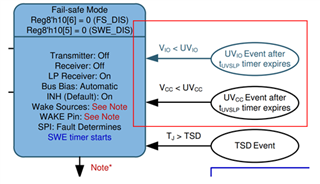Hello team,
I have a couple of questions regarding the device state.
1) In case of switching to sleep mode with VSUP, VIO and VCC then the VIO and VCC are removed after a period of time, will it be stayed in Sleep mode? (If a trigger such as VIO<UVIO, we are concerned that there is a possibility to be the Fail-safe mode or the mask settings of WUF set during the Sleep mode transition will disappear.)
2) In case of shorting the RXD pin to GND then switching to Sleep mode with VSUP and VIO supplied, we confirmed that about 20mA current flowing from the RXD pin. In the Normal mode, we think that the current flowing from this RXD can be suppressed to the order of uA. Is it possible to suppress uA order in the same way by register setting etc. in the Sleep mode as well?
Thanks in advance.
S.Sawamoto

